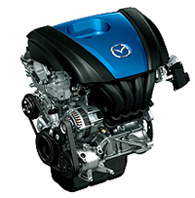Mazda Develops Highly Efficient 'SKYACTIV-G 1.3' Direct-Injection Gasoline Engine
 "SKYACTIV-G 1.3" |
FYI: Mazda Buyers Guide and Reviews
Tokyo, May 18, 2011; Mazda Motor Corporation has announced that
the "SKYACTIV-G 1.3" direct-injection 1.3-liter gasoline engine will be the
first of its next-generation SKYACTIV technologies to be introduced to the
market. Mazda will unveil the engine at the Automotive Engineering
Exposition that will be held from May 18 through 20, 2011, at the Pacifico
Yokohama convention center near Tokyo, Japan.
The breakthrough
SKYACTIV-G 1.3 achieves a record high compression ratio (for a regular
gasoline mass production automobile engine) of 14.0:1 and exhibits high
efficiency, especially under high load at low rpm. In order to avoid
knocking - an unavoidable issue with conventional high-compression engines
- the SKYACTIV-G 1.3 features a number of new technologies, such as piston
cavities that are specially designed to support ideal combustion, and
multi-hole injectors that enable precise fuel injection
control.
Mazda plans to introduce the SKYACTIV-G 1.3 to the Japanese
market in the facelifted Mazda2 (known in Japan as the Demio) during
the first half of 2011. It will be the first ever 1.3-liter
direct-injection gasoline engine to be equipped in a compact car
manufactured in Japan. Combined with Mazda's unique idling stop system,
i-stop, and a continuously variable transmission (CVT), SKYACTIV-G 1.3 will
achieve fuel economy of 30km/L under Japan's 10-15 mode test
cycle.
Mazda has applied for over 130 patents in relation to the
engine (as of the end of February, 2011).
The SKYACTIV-G 1.3
Engine
SKYACTIV TECHNOLOGY is the umbrella term for Mazda's range of
next-generation technologies - including gasoline and diesel engines,
transmissions, and a new body and chassis - that significantly improve
vehicle driving dynamics as well as environmental and safety performance.
The SKYACTIV-G 1.3 that is equipped in the facelifted Mazda Demio adopts
all of Mazda's SKYACTIV engine technologies except for the exhaust
manifold. It also features other new components that are exclusive to the
Demio, such as a cooled EGR* system.
Under its Sustainable Zoom-Zoom
vision, Mazda aims to deliver outstanding driving pleasure as well as
environmental and safety performance, and is committed to increasing its
global fleet fuel economy by 30 percent by 2015, compared with the 2008
level.
Main features of the SKYACTIV-G 1.3 engine
- Highly
efficient automobile gasoline engine and the world's first to achieve a
compression ratio of 14.0:1
- Multi-hole injectors enable precise fuel
injection control for ideal combustion
- Mazda's first dual sequential
valve timing system (dual S-VT with electronically-operated intake) in
combination with the high compression ratio achieves an unconventional
Miller cycle (extremely delayed closure of intake valves) that improves
efficiency
- Compact combustion chambers have a longer stroke for better
efficiency
- Piston cavities are specially designed to support ideal
combustion
- 30 percent less mechanical friction, due to a narrower
crankshaft, new roller followers and low-tension piston rings that also
reduce oil consumption
- Various countermeasures to prevent knocking,
including a cooled EGR system
- An updated version of Mazda's innovative
idling stop system, i-stop, improves fuel economy by eight percent. It
operates with a higher frequency, requires less fuel to restart, and
achieves a smoother restart
- A lightweight and highly rigid aluminum
alloy engine block
Major specifications of the SKYACTIV-G
1.3
- Inline four-cylinder 1.3-liter direct-injection engine (with
i-stop)
- Engine displacement: 1.298/L
- Bore and stroke: 71.0mm x
82.0mm
- Compression ratio: 14.0:1
- Maximum output (net): 62k/w @
5,400rpm (84ps @ 5,400rpm)
- Maximum torque (net): 112Nm @ 4,000rpm
* EGR: Exhaust Gas Recirculation
About Mazda
Mazda Motor Corporation started
manufacturing tools in 1929 and soon branched out into production of trucks
for commercial use. In the early 1960s, Mazda launched its first passenger
car models and began developing rotary engines. Still headquartered in
Hiroshima in western Japan, Mazda today ranks as one of Japan's leading
automakers, and exports cars to the United States and Europe for over 30
years. For more information, please visit www.mazda.com.


